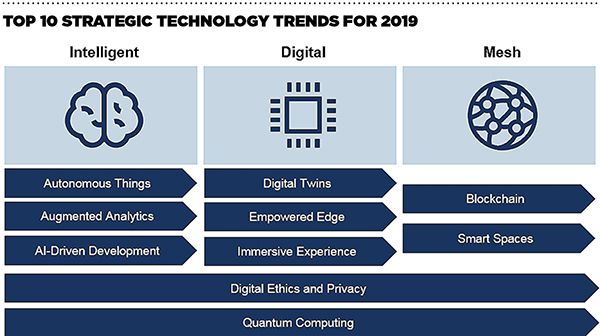Technology Trends You Can’t Ignore

Strategic technology trends have the potential to drive significant disruption and deliver significant opportunity. Enterprise architecture and technology innovation leaders must evaluate these trends to identify opportunities, counter threats, and create competitive advantage, according to a recent Gartner report.
Key Report Findings
Artificial intelligence (AI) opens up a new frontier for digital business. This is because virtually every application, service, and Internet of Things (IoT) object incorporates an intelligent aspect to automate or augment application processes or human activities.
The way we perceive and interact with technology is undergoing a radical transformation. Conversational platforms, augmented reality, virtual reality, and mixed reality will provide more natural and immersive ambient experiences within the digital world.
Digital representations of things and organizational processes are increasingly used to monitor, analyze, and control real-world environments. These digital twins combined with AI and immersive experiences set the stage for open, connected, and coordinated smart spaces.
Formal mechanisms to identify technology trends and prioritize those with the biggest potential impact on the business create competitive advantage.
Recommendations
Enterprise architecture (EA) and technology innovation leaders driving business transformation through technological innovation must:
- Explore ways that AI-driven autonomous capabilities can power essentially any physical device within the organization or the customer’s environment.
- Educate, engage, and ideate with senior business leaders about their strategically relevant priorities and where AI can automate or augment human activities.
- Develop and deploy a mix of platforms that incorporate conversational interactions with virtual, augmented, and mixed reality for targeted use cases to create an immersive user experience.
- Support IoT initiatives by developing and prioritizing targeted, high-value business cases to build digital twins of physical things and organizational processes.
- Learn about and monitor quantum computing while it is still in the emerging state. Identify real-world problems where it has potential and assess its possible impact on security.
Strategic Planning Assumptions
- By 2021, 10% of new vehicles will have autonomous driving capabilities, compared with fewer than 1% in 2018.
- By 2021, half of large industrial companies will use digital twins, resulting in a 10% improvement in effectiveness for those organizations.
- By 2021, organizations that bypass privacy requirements and are caught lacking in privacy protection will pay 100% more in compliance costs than competitors that adhere to best practices.
- By 2022, at least 40% of new application development projects will have artificial intelligence co-developers on the team.
- By 2022, 70% of enterprises will be experimenting with immersive technologies for consumer and enterprise use, and 25% will have deployed them to production.
- By 2022, more than 50% of all people collaborating in Industry 4.0 ecosystems will use virtual assistants or intelligent agents to interact more naturally with their surroundings and with people.
- By 2023, 20% of organizations will be budgeting for quantum computing projects, compared to fewer than 1% in 2018
- Through 2028, storage, computing, and advanced AI and analytics technologies will expand the capabilities of edge devices.
- By 2030, blockchain will create $3.1 trillion in business value.
SOURCE: Gartner, The 2019 Top Supply Chain Technology Trends You Can’t Ignore, March 2019, Andrew Stevens, Christian Titze
